Samuel O. Adeyemo 1, Gbenga M. Oyinloye 2, Theodore Mbata 3
1Department of Mathematics and Statistics, Federal Polytechnic, Nekede, Owerri, Imo State, Nigeria
2Department of Food Technology, Federal Polytechnic, Nekede, Owerri, Imo State, Nigeria
3Department of Biology/MicroBiology, Federal Polytechnic, Nekede, Owerri, Imo State, Nigeria
Correspondence to: Samuel O. Adeyemo , Department of Mathematics and Statistics, Federal Polytechnic, Nekede, Owerri, Imo State, Nigeria.
| Email: |  |
Copyright © 2022 The Author(s). Published by Scientific & Academic Publishing.
This work is licensed under the Creative Commons Attribution International License (CC BY).
http://creativecommons.org/licenses/by/4.0/

Abstract
The prevalence of non-medical use of pharmaceutical drugs among students of tertiary institutions in Nigeria has generated an outcry by the populace and has become a public health concern. This study aimed to investigate the prevalence of non-medical use of pharmaceutical drugs among tertiary institutions students in Imo and Enugu states, Nigeria; describe the pattern of non-medical use of pharmaceutical drugs among the tertiary schools student population in the study areas, as well as examine the social-demographic factors that associate with drug use among the tertiary schools student population in the study areas. Cross-sectional study design and multi-stage sampling method were utilized among 309 study participants who gave informed consent/assent. Data were collected using facilitated, self-administered questionnaire. Descriptive and inferential statistics were carried out at p<0.05. The mean age of our respondents was 25.29±6.07SD. The most used drug was codeine with 26.9% of the sample reporting lifetime use, while 18.8% and 13.6% reported codeine use in the past year and past month respectively. It was also shown that of the respondents who started using drugs, 6.1% are because they like the feeling. The study shows statistical differences according to sex, regardless of the age and living situation of the students.
Keywords:
Non-Medical use of Pharmaceutical drugs, Tertiary Institution Students, Prevalence
Cite this paper: Samuel O. Adeyemo , Gbenga M. Oyinloye , Theodore Mbata , A Study of the Non-Medical Use of Pharmaceutical Drugs among Tertiary Institution Students in South-East Nigeria, International Journal of Statistics and Applications, Vol. 12 No. 1, 2022, pp. 10-15. doi: 10.5923/j.statistics.20221201.02.
1. Introduction
The problem of drug abuse has grown to become a prevailing phenomenon in the contemporary society, and more disturbing is the rate of involvement of the young population in this damaging behavior which poses great threat to the entire society as a result of diverse associated physical, psychological and social adverse effects and consequences. Previous cases of use and abuse of drugs are commonly identified with the adult population, but findings have established the spread of psychoactive substance use to the younger populations potentially leading to addiction (Bonomo & Bowes, 2001). The report of UNODC (2013) also established that youths especially in Africa engage in utilizing different kinds of psychotropic substances. The West Africa Commission on Drugs (2014) affirmed that Nigeria is one of the countries that are most affected by the problem of consumption and dependence on drugs particularly among the youths. From the observation of Usman (2015), the rate of drug dependency is increasing among Nigerian youths because unlike in the past when Nigeria is only a route of drug-trafficking, drugs are now being produced and really available for consumption in Nigeria.Many Nigerian young individuals experiment with drug at some point in life, particularly; alcohol, nicotine, cannabis and more distressing in the recent time, pharmaceutical / prescription drugs such as tramadol, codeine containing cough syrup, rohypnol, and diazepam. A lot of people become persuaded to initiate non-medical use of pharmaceutical drugs because such drugs are often regarded as “safe drugs” for a number of reasons including: their status as prescription drugs being used as medicinal, easily accessibility, affordability, and the fact that some often do not have offensive odour and can be used for a long time without being easily detected. The rise in the rate of pharmaceutical opiods abuse among young Nigerians has generated an outcry by the populace. Notable is the recent debate on the situation at the National House of Representatives, where members of the House, citing the prevalence of Tramadol and Codeine abuse in Kano and Jigawa states, reiterated the disturbing state of the problem in the country (Ameh, 2017).Non-medical use of prescription opioids such as tramadol and codeine containing cough syrup has recently been reported as the second most commonly used drugs after cannabis among individuals aged between 15 and 64 years in Nigeria (UNODC, 2018). The prevalence of the practice of non-medical use of pharmaceutical drugs among tertiary institution students in southeastern Nigeria has not been widely studied. The factors that influence non-medical use of pharmaceutical drugs practices remain issues of intense debate in academic discourse.
2. Problem Statement and Justification
These practices have raised a lot of unresolved research questions such as: Which benefit do tertiary institution students derive through non-medical use of pharmaceutical drugs? Is there any relationship between level of education and non-medical use of pharmaceutical drugs practices? What factors influence non-medical use of pharmaceutical drugs among tertiary institution students? What strategies can be crafted to discourage non-medical use of pharmaceutical drugs in general?
3. Objectives of the Study
1. To investigate the prevalence of non-medical use of pharmaceutical drugs among tertiary institutions students in Imo and Enugu states, Nigeria.2. To describe the pattern of non-medical use of pharmaceutical drugs among the tertiary schools student population in Imo and Enugu states, Nigeria.3. To examine the social-demographic factors that associate with drug use among the tertiary schools student population in Imo and Enugu states, Nigeria.
4. Literature Review
Previous studies have established the non-medical use of various pharmaceutical drugs among the young Nigerians especially the student population. For instance, in a study conducted by Onyencho, et al., (2015), tramadol, rohypnol, diazepam, and codeine emerged among the top ten drugs being used by young Nigerians. Furthermore, codeine was reported as the most frequently used substance, followed by alcohol, cannabis, tramadol, rohypnol, and tobacco among university undergraduates (Adekeye, Odukoya, Chenube, Igbokwe, Igbinoba, & Olowookere, 2017). Agberotimi, Osinowo, Asagba and Akinawo (2018) in an investigation of pattern of substance abuse among youths in Ogbomoso, southwest Nigeria, found that codeine and tramadol are among the five most frequently used drugs among the population surveyed.According to the UNODC (2018) report, drug abuse prevalence was reported highest in the south-east when compared with other regions in the south geopolitical zones. The report further affirmed that drug use is highly prevalent in Imo and Enugu states with prevalence rate as high as 22% of people aged between 15 and 64 years. Substance abuse by young people has been closely identified with various forms of psychological and behavioural problems such as severe substance use disorder in later years, delinquency, and criminality (Abdu-Raheem, 2013). Globally, about 2% of cause-particular disability-adjusted life-years (DALYs) for youngsters in the age range 10-24 years are attributed to the use of illicit substances (Gore, et al., 2011). In a similar vein, youths with problems of substance abuse also present in larger proportion for other mental health conditions compared to their non-drug using counterparts (Igwe & Ojinnaka, 2010). Prevailing loss of societal values, corruption and moral decadence in the contemporary society has also been associated with substance abuse among Nigerian youths (Abudu, 2008, Usman, 2015).Regardless of the kind of drug or why it is used, many grave consequences are undoubtedly associated with the drug use. For instance, drug abuse constitutes one of the most outstanding socio-psychological hazards that can easily wreck one’s personal, family and social life (Massah, Farmani, Karimi, et al, 2015). Unfortunately, the problem is not limited to people that abuse drugs but the entire society. Drug use and abuse has been established as strongly associated with several public health concerns such as HIV/AIDs, рооr асаdеmіс performance, truancy, delinquencies, loitering, reduced job productivity and loss of employment, marital and family distress, divorce, domestic violence, rape, accidents, kidnapping, robbery and other criminal activities, suicide and homicide, to mention but few (WHO, 2011; Abdu-Raheem, 2013; Igwe & Ojinnaka, 2010; Olley, 2008; Ekpenyong & Aakpege, 2014).Drug use occurs within the context of an individual’s prevailing biological, psychological, and social factors. Understanding how these factors (psychological and social in particular) relate to drug use in a population has been proven effective in preparing and delivering evidence-based drug use prevention and intervention. In this regards, extensive research has been conducted on the relationship between drug use and factors such as self-esteem, peer influence, social support, and emotional disturbances (e.g. Nalah & Audu, 2014, Masibo, Mndeme, & Nsimba, 2013, Asagba, Chovwen, Alarape, & Agberotimi, 2016).The aforementioned notwithstanding, there are limited studies addressing the prevalence, pattern and psycho-social correlates of non-medical use of pharmaceutical drugs among student population in the south-east Nigeria. The present study therefore investigated the prevalence, patterns, and psycho-social correlates of non-medical use of pharmaceutical drugs among tertiary students in Imo and Enugu states of the south-east Nigeria.
5. Design
A cross-sectional survey design was used. Cross-sectional studies involve data collected at a defined time. They are often used to assess the prevalence of acute or chronic conditions.
5.1. Description of Study Setting
The study location is Imo and Enugu states, Nigeria. Imo and Enugu states are from the 5 states that constitute the south-east geopolitical zones of Nigeria. They both have a high prevalence of drug use in the states as reported by the UNODC 2018 report.
5.2. Description of Study Participants
The study population for the study comprised of students in the tertiary institutions in Imo and Enugu states.
5.3. Sampling
Multistage sampling method was adopted. In the first stage, purposive sampling technique was used to select Imo and Enugu states from the 5 states that constitute the south-east geopolitical zones of Nigeria based on the high prevalence of drug use in the states as reported by the UNODC 2018 report. In the second stage simple random selection technique was used to select 3 tertiary institutions (one from each categories of university, polytechnic and college) from each state i.e. Imo and Enugu. The third stage also involved the use of simple random sampling technique to select 3 faculties from each institutions, making 18 faculties all together. Finally, convenience sampling technique was used to recruit respondents from each faculty of the institutions.Table 1. Annual prevalence of drug use by state in South-East zone
 |
| |
|
5.4. Data Collection Instruments
A structured questionnaire containing an adapted version of the UNODC Problem Drug Questionnaire, drug involvement questionnaire, as well as information on demographic attributes of respondents was utilized.
5.4.1. Procedure
Ethical approval was obtained from the nearest National health research ethics committee in charge of ethical clearance for health and social research. Secondarily, approval was duly obtained from the authorities of the various institutions. Thereafter, students that met the inclusion criteria were approached at different locations such as lecture theatres, lounge, and sport arena; the purpose, risk and benefits of the study were explained to them. Potential participants were assured of their confidentiality. Informed consent processes was duly followed. Participants that willingly consented were administered the research questionnaire. The questionnaire required about 15 minutes for completion.
5.4.2. Data Analyses
Returned questionnaires were carefully stored and coded for data analysis using the Statistical Package for the Social Sciences 23.
6. Results
SOCIO-DEMOGRAPHIC CHARATERISTICSThe results of the descriptive statistics presented in Table 2 showed that more males (58.9%) participated in the study compared to their female counterparts who constituted 41.1% of the sample. The table also showed the majority of the participants aged between 16 and 25 years (60.5%), followed by those aged between 26 and 35 years who constituted 31.4% of the participants, while 6.1% of the participants were between the ages 36 and 45 years, and only 0.6% aged 46years and above. The table also presented the descriptive statistics analysis results on the participants’ ethic groups and showed that the majority of the participants were Igbos (86.1%), while 7.4% were Yoruba, 1% Hausa, 3.9% from other ethnic groups, and the remaining 1.6% did not indicate their ethnic group. Data on marital status of the participants’ parents revealed that 47.9% were married, 43% were not married, 1.3% were separated or divorced, 3.9% were widowed, and 3.9% of the participants did not indicate the marital status of their parents. Finally, data on participants’ living situation revealed that 27.8% of the participants reported living alone, 17.5% with partner, 14.6% with friends, 28.2% live with their parents, 9.1% indicated living with dependents, and 1.9% indicated other unspecified living situation, while the remaining 1% did not respond. Finally, the majority of the students (44.3%) were students at the federal polytechnic Nekede.Table 2. Socio-Demographic Characteristics of Survey Participants (n = 309)
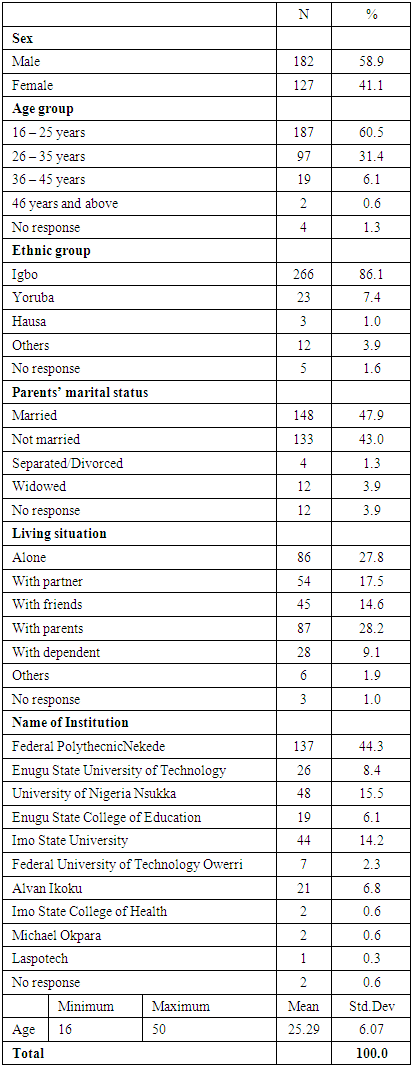 |
| |
|
Objective One: To investigate the prevalence of non-medical use of pharmaceutical drugs among tertiary institutions students in Imo and Enugu states, Nigeria.The result presented in Table 3 showed the prevalence of pharmaceutical drug use among the participants. The most used drug was codeine with 26.9% of the sample reporting lifetime use, while 18.8% and 13.6% reported codeine use in the past year and past month respectively. The least consumed substance among the participant was rohypnol, with lifetime prevalence of 1.3%, and no report of use in the past year and month. Table 3. Prevalence of Pharmaceutical Drug Use among the Participants
 |
| |
|
Objective Two: To describe the pattern of non-medical use of pharmaceutical drugs among the tertiary schools student population in Imo and Enugu states, Nigeria.The results presented on Table 4 revealed the reasons for initiating drug use as reported by the drug-using participants. It was shown that 6.1% of the participants started using drugs because they like the feeling, 3.1% because they wanted to be like their friends, 4.9% because they felt bored and just wanted to have fun, 5.2% reported use because of stress, worries or personal problems, and 3.2% of the in-school adolescents and youths sample indicated sad feeling, loneliness and being sorry for self as their reason for using drugs.Table 4. Reason for Initiating Drug Use
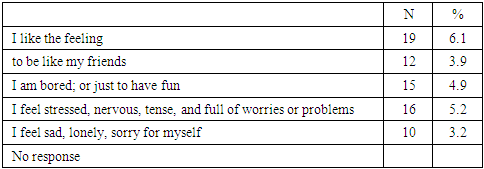 |
| |
|
The result presented on table 5 revealed different sources by which participants obtain drugs. Among the students, 11.3% reported they obtain drugs under the supervision of their parents or relatives.Table 5. How drug is obtained
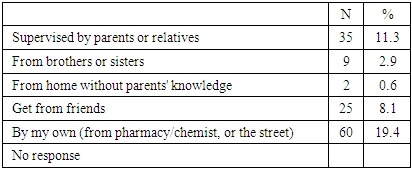 |
| |
|
The results presented on table 6 showed the age of first drug use. Among the participants that reported drug use 16.8% started drug use after the age of 15years.Table 6. Age of First Drug Use
 |
| |
|
The result obtained on table 7 revealed the time of the day that drug is usually used. The majority of the drug-using participants (19.7%) reported night as the time they usually use drugs.Table 7. Time of the Day Drug is Usually Used
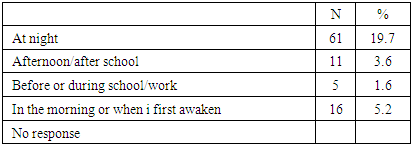 |
| |
|
Results presented on table 8 revealed information about whom drug is usually used. Among the sampled population, 6.8% of the respondents reported they use drugs together with their parents or adult relatives. Table 8. With Whom Drugs is Usually Used
 |
| |
|
Results obtained from table 9 showed participants’ response on effect they have had from drugs. Among respondents, 11.3% have only experienced loose, easy feeling from taking drugs.Table 9. Immediate/short term effect had from drugs
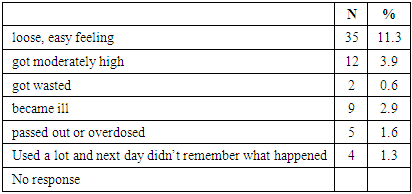 |
| |
|
Data on the question eliciting response on what effect has using drugs had on the participants life is presented on table 10. Among respondents, 27.2% indicated using prescription drugs has not had any negative effect on their lives. Table 10. Consequences of Drugs Use
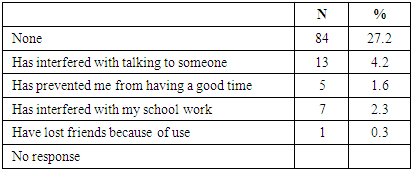 |
| |
|
Results obtained on table 11 revealed data on how respondents feel about their drug use. Many of the participants’ (15.2%) indicated they do not see any problem with their drug use.Table 11. Feeling about Drugs
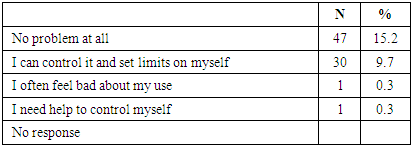 |
| |
|
Objective Three: To examine the social-demographic factors that associate with drug use among the tertiary schools student population in Imo and Enugu states, Nigeria.The results obtained on table 12 showed the significant gender difference in drug use t (65) = 2.98, p<.05. This implies that the rate of drug use is significantly different between the male and female participants, with the males reporting a mean of 26.05 on measure of drug use compared to the mean of 18.29 reported by the female participants. This indicates the average usage of drugs among the gender.Table 12. Summary Table of Independent Sample T-Test Showing Gender Difference on Drug Use Among The Participants
 |
| |
|
The results revealed that age group of the participants did not significantly influence drug use (F (2,63) = .15, p>.05). The results imply that the rate of drug use is relatively similar among the participants irrespective of their ages.The results also showed that there was no significant influence of drug use by living situation among the participants (F (5,61) = .85, p>.05). The results imply the living situation of the participants did not significantly influence their drug use.
7. Conclusions
Our findings underscore an urgent need to intensify drive for awareness against non-medical use of pharmaceutical drugs among students of tertiary institutions in Nigeria. It also revealed that tertiary institution students misuse pharmaceutical drug other than medical usage. While codeine was the most used with 26.9% of the sample reporting lifetime use, the least consumed substance among the participant was rohypnol, with lifetime prevalence of 1.3%.In conclusion, age group of the participants did not significantly influence drug use. The results imply that the rate of drug use is relatively similar among the participants irrespective of their ages. Also, there was no significant influence of drug use by living situation among the participants. The results imply the living situation of the participants did not significantly influence their drug use.The COVID-19 pandemic and eventual lockdown caused a great limitation in data collection. The researcher had to result to online data collection to ameliorate the effect. Future studies should possibly consider alternative methods of collecting the data. Other studies could also look at treatment and prevention of drug abuse.
ACKNOWLEDGEMENTS
The team of researchers wish to acknowledge TETFUND, Nigeria for sponsoring and facilitating this research. Also Federal Polytechnic Nekede, the host institution.
References
| [1] | Y. Bonomo & G. Bowes, G., 2001 Annotation: putting harm reduction into an adolescent context. Child Health, 37, 5-8. |
| [2] | United Nations Office on Drugs and Crime, 2013. World drug Report. Vienna: UNODC. |
| [3] | Y. Usman., 2015. Combating Drug Abuse through Adult Education in Nigeria. International Journal of Humanities and Social Science Invention, 4 (3), 36-40. |
| [4] | J. Ameh. 2017. Drug Abuse worries Reps, want Codeine, Tramadol banned. Punch Newspaper: Online Edition. Retrieved from https://punchng.com/drug-abuse-worries-reps-want-codeine-tramadol-banned/ August 2019. |
| [5] | United Nations Office on Drugs and Crime, 2018. Drug Use in Nigeria. Retrieved from http://33h.co/kyvsv. |
| [6] | V. C. Onyencho, A. W. Ibrahim, S. K. Pindar, M. Duwap, A. A. Mshelia, B.I. Rabbebe, M. M. Yerima, and A. K. Baba, 2015. Personality traits of in-patients with substance use disorders in a mental health facility in Nigeria. Journal of Neuroscience and Behavioral Health, 8(1), 1-8. |
| [7] | O. A. Adekeye, J. A. Odukoya, O. Chenube, D. O. Igbokwe, A. Igbinoba and & E. I. Olowookere. 2017. Subjective Experiences and Meaning Associated with Drug Use and Addiction in Nigeria: A Mixed Method Approach. Global Journal of Health Science, 9 (8), 57-65. |
| [8] | S. F. Agberotimi, H. O. Osinowo, R. B. Asagba and E. O. Akinnawo, 2018. Pattern of Drug Usage among Youths Receiving Treatment for Substance Use Disorder in Ogbomoso, Nigeria. Paper presented at the 2018 Nigerian Association of Clinical Psychologists’ Scientific Conference, Ede, Osun State, Nigeria, 9th – 10th May. |
| [9] | B. O. Abdu-Raheem, 2013. Sociological Factors to Drug Abuse and the Effects on Secondary School Students’ Academic Performance in Ekiti and Ondo States, Nigeria. Contemporary Issues in Education Research 6 (2), 233 – 240. |
| [10] | F. M. Gore, P. J. Bloem, G. C. Patton, J. Ferguson, V. Joseph, C. Coffey, S. M. Sawyer, and C. D. Mathers, 2011. Global burden of disease in young people aged 10-24 years: A systematic analysis. Lancet, 377(9783): 2093- 2102. |
| [11] | W. C. Igwe and N. C. Ojinnaka, 2010. Mental health of adolescents who abuse psychoactive substances in Enugu, Nigeria - a cross-sectional study. Ital J Ped 36, 53. |
| [12] | V. Abudu, 2008. Young People and Drug Abuse. A Paper Presented at the 8th Biennial International Conference on Alcohol, Drugs and Society in Africa, Abuja, Nigeria between 23rd – 25th July, 2008. |
| [13] | O. Massah, F. Farmani, R. Karimi, H. Karami, F. Hoseini and A. Farhoudian, 2015. Group Reality Therapy in Addicts Rehabilitation Process to Reduce Depression, Anxiety and Stress. Iranian Rehabilitation Journal, 13(1), 44 – 50. |
| [14] | World Health Organization, 2011. Alcohol: Fact sheet. Retrieved from World Health Organization Web site: http://www.who.int/mediacentre/factsheets/fs349/en/index.html. |
| [15] | B. O. Olley, 2008. Child sexual abuse, harmful alcohol use and age as determinants of sexual risk behaviours among freshmen in a Nigerian university. African Journal of Reproductive Health, 12 (2), 75-88. |
| [16] | N. S. Ekpenyong, and N. Y. Aakpege, 2014. Alcohol Consumption Pattern and Risky Behaviour: A Study of University of Port Harcourt. IOSR Journal of Humanities and Social Science (IOSR-JHSS), 19(3, 1), 25-32. Retrieved from www.iosrjournals.org. |
| [17] | A. B. Nalah, and G. Audu, 2014. Substance Use and Violent Behaviour of Students in Nasarawa State University, Keffi – Nigeria. Academic Research International 1(10), 3418-3437. DOI: 10.1037/rnSV0000004. |
| [18] | R. M. Masibo, E. Mndeme, and S. E. D. Nsimba, 2013. An Assessment of Knowledge, Attitudes and Practices of Psychoactive Substance Use among Secondary School Students in Dodoma Municipality, Tanzania. American Journal of research Communication, 1(4), 200-240. |
| [19] | R. B. Asagba, C. O. Chovwen, A. I. Alarape and S. F. Agberotimi, 2016. Psychosocial predictors of drug involvement among secondary school students. Journal of Social Sciences, 5(1), 7 – 12. |
| [20] | West Africa Commission on Drugs (2014). Not Just in Transit: Drugs, the State and Society in West Africa. An Independent Report of the. West Africa Commission on Drugs. |



 Abstract
Abstract Reference
Reference Full-Text PDF
Full-Text PDF Full-text HTML
Full-text HTML










